#carola neher
Explore tagged Tumblr posts
Photo

Rolf Mahrenholz, Carola Neher (in Die Dame 6, 1930-31)
Carola Neher (born Karoline Neher; 2nd November 1900 – 26th June 1942), German actress and singer
In 1932 she married Anatol Becker and left Germany after Hitler's ascension to power in spring 1933. She first emigrated to Prague, where she worked at the New German Theater, but went on to the Soviet Union in 1934, where she met Gustav von Wangenheim and worked with him at his cabaret Kolonne Links.
In 1936, during the Great Purge, Wangenheim denounced Neher and Becker as Trotskyites and she was arrested on 25th July 1936. Becker was executed in 1937, while Neher was sentenced to ten years in prison and sent to the prison for political convicts in Oryol.
As the German army approached Oryol in October 1941, she was transferred to NKVD Prison No. 2 near Orenburg, where she died of typhus on 26th June 1942, aged 41. Neher (prisoner number 59783) was buried in an unmarked mass grave. Her son, Georg, became a music teacher and only found out about his parents' identity in 1975.
image from here, text abridged from here
7 notes
·
View notes
Photo

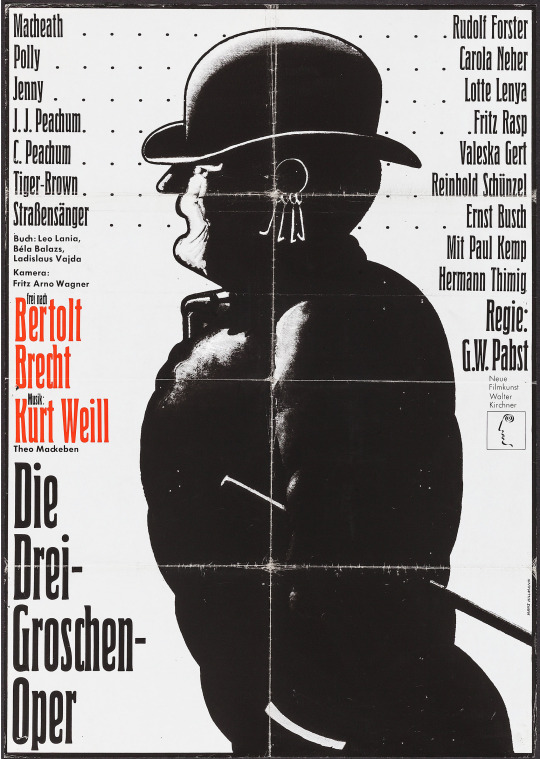
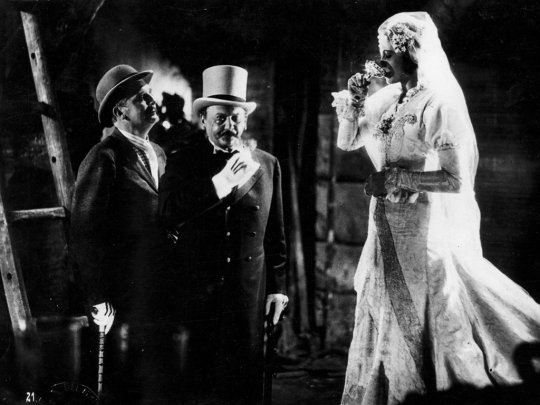
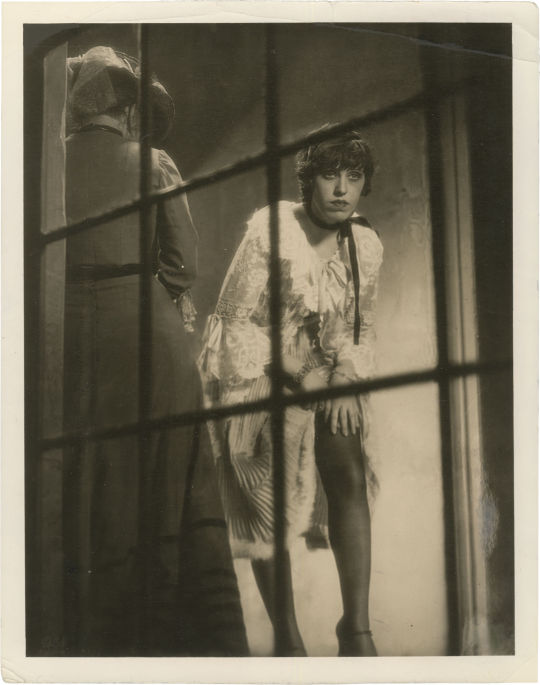
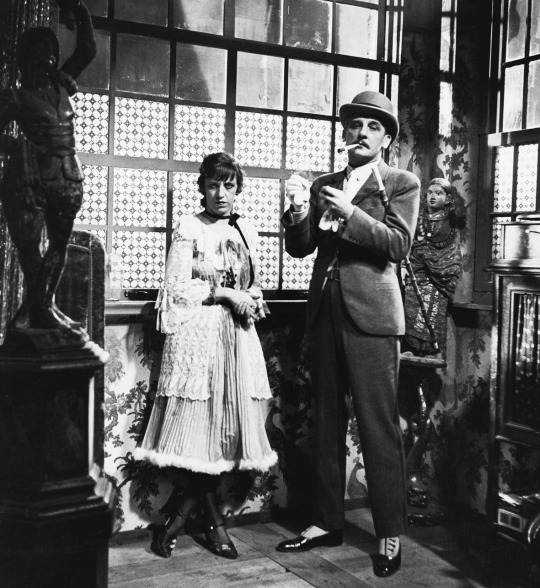
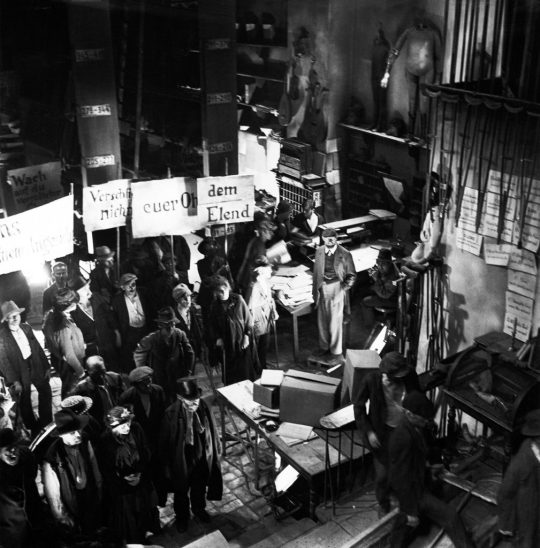
The 3 Penny Opera (Die 3 Groschen-Oper) (1931) G.W. Pabst
May 21st 2023
#the 3 penny opera#die 3 groschen-oper#1931#g. w. pabst#rudolf forster#carola neher#reinhold schunzel#fritz rasp#valeska gert#lotte lenya#ernst busch#vladimir sokoloff#the threepenny opera
8 notes
·
View notes
Photo

Rudolf Forster and Carola Neher in The Threepenny Opera (G.W. Pabst, 1931)
Cast: Rudolf Forster, Carola Neher, Reinhold Schünzel, Fritz Rasp, Valeska Gert, Lotte Lenya, Hermann Thimig, Ernst Busch. Screenplay: Béla Balász, Léo Lania, Ladislaus Vaida, based on a play by Bertolt Brecht adapted from a play by John Gay. Cinematography: Fritz Arno Wagner. Art direction: Andrej Andrejew. Film editing: Hans Oser. Music: Kurt Weill.
In 1928, Bertolt Brecht and Kurt Weill transformed John Gay's 18th-century Beggar's Opera into Die Dreigroschenoper, one of the most celebrated works to come out of Weimar-era Germany, so when sound came to film it was inevitable that the musical should become a movie. But both Brecht and Weill were unhappy with what Pabst decided to do with both the plot and the songs, so they sued. Brecht lost, but Weill won, with the result that although songs were cut from the film, no new music by other composers was added. Brecht's objections seem to be more about a loss of control over the screenplay than about any ideological shift: If anything, the ending of the film goes even further left than Brecht's did, with the crooks and corrupt officials of the play becoming bankers. Pabst's direction is sometimes a little slow and stiff: He had never done a musical film before, and the action between songs often seems to lag. But the musical numbers that remain -- which include the well-known "Moritat" or "Mack the Knife," Lotte Lenya's delivery of "The Ballad of the Ship With Fifty Cannons," and "The Song of the Heavy Cannon" -- are well-handled. The cast includes Rudolf Forster as Mackie Messer (i.e. Mack the Knife), Carola Neher as Polly Peachum, Fritz Rasp as Peachum, and Lenya as Jenny. It's striking to see that, as in Fritz Lang's M, made the same year, the underworld is presumed to consist of syndicates of thieves and beggars. The cinematography is by Pabst's frequent collaborator, Fritz Arno Wagner, and the splendid sets are by Andrej Andrejew.
2 notes
·
View notes
Text



Carola Neher (1900-1942) is a German actress, who rose to fame in Weimar Berlin.
Of great beauty, she was one of Bertolt Brecht's emblematic actresses, having played in several of his plays, in The Threepenny Opera in particular.
Fleeing the Nazi regime, she took refuge in the Soviet Union, where the Stalinist regime sent her in the Gulag as part of the Great Purges. She died in 1942 in Sol-Iletsk.
1 note
·
View note
Text
Peter Lorre + Joan of Arc (Radio)
Bertolt Brecht transformed Joan of Arc into Joan Dark in his musical comedy "Die heilige Johanna der Schlachthöfe" (St. Joan of the Stockyards).
What I didn't realize before was that Brecht based "St. Joan" - written between 1929 and 1931 - on his earlier play, "Happy End" (1929) - which also had Peter Lorre.
Fortunately for us, we can hear Peter's lovely voice in "St. Joan"!
Get Brecht's St. Joan script [English, PDF].
Listen to the 1932 Berlin radio broadcast of "St Joan":
youtube
This broadcast is brought to you by @peterlorres21stcentury's sleuthing work from over a year ago. You can also access the St Joan recording on archive.org per @charlottecremababe.
Lorre played two characters: Sullivan Slift and Graham. As Slift, he is supposed to show Johanna the wickedness of the poor so that she loses her pity.
The broadcast stars Carola Neher as Joan and Fritz Kortner as Mauler. The performers included Helene Weigel, Ernst Busch, Paul Bildt and Friedrich Gnaß.
"In this version of the story of Joan of Arc, Brecht transforms her into "Joan Dark", a member of the "Black Straw Hats" (a Salvation Army-like group) in 20th-century Chicago. The play charts Joan's battle with Pierpont Mauler, the unctuous owner of a meat-packing plant. Like her namesake, Joan is a doomed woman, a martyr and (initially, at least) an innocent in a world of strike-breakers, fat cats, and penniless workers. Like many of Brecht's plays it is laced with humor and songs as part of its epic dramaturgical structure and deals with the theme of emancipation from material suffering and exploitation." Wiki
Intrigued by the aforementioned "Happy End"? Go here:
#peter lorre#peter lorre radio#peter lorre plays#peter lorre stage#peter lorre theatre#bertolt brecht#Happy End#Saint Joan of the Stockyards#St. Joan of the Stockyards#Die heilige Johanna der Schlachthöfe
9 notes
·
View notes
Text
I've found it! I wasn't expecting to, but I've found a recording of a Brecht play with Peter in it! You'll first hear him at the 12 minute mark
6 notes
·
View notes
Photo
Peter Lorre as Pipi the Clown in Alfred Savoir's circus farce "Der Dompteur" (The Lion Tamer), staged at the Theater am Schiffbauerdamm, Berlin, March 1931.
From The Lost One: A Life of Peter Lorre:
"Picked apart by the critics for its cheap sophistication, Savoir’s love triangle between a circus rider, a lion tamer, and a decadent lord quickly collapsed, despite finding a receptive audience that appreciated the production’s erotica and diverse surprises. The ensemble fared well with theatergoers and critics alike. With only the thinnest thread of interest given to his role as a melancholic clown, who sighs with his 'suggestive voice,' the gifted Peter Lorre was hailed in 'mask and play, truest circus.'"
Here is Peter/Pipi with Carola Neher as Arabella (June 3, 1931):

From The Argus (Melbourne, Victoria, Sat 7 May 1927, page 12):
"The symbolic method is used in 'Le Dompteur,' by Alfred Savior. Brute force and pacifism are represented by a lion-tamer and an English peer. The 'lord' follows the tamer from town to town, hoping that some day the lions will eat their brutal master, but in the end the lions eat the lord when he tries to train them by pacific methods."

I found this photo of young Peter Lorre while searching instead for a picture of F. Wedekind as the Tamer in Lulu.
#peter lorre#i am not a clown aficionado but hell it's peter lorre so it's okay#especially a melancholic clown#especially one named Pipi#wonder if anyone ever teased him about being a Pipi and then a Pepi#Der Dompteur#peter lorre theatre#peter lorre stage#peter lorre plays
31 notes
·
View notes
Photo

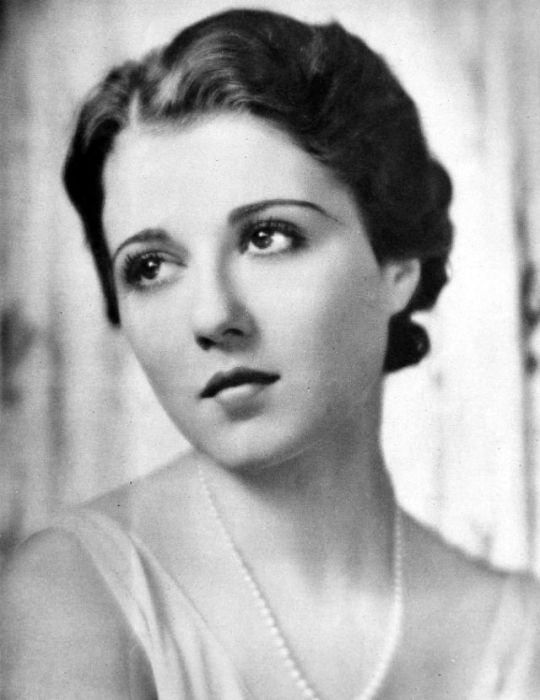


ACTRESSES WHO DIED 1942
Carole Lombard at 33 from plane crash
Sidney Fox at 34 from suicide
Jeanette Loff at 35 from ammonia poisoning
Carola Neher at 41 from typhus
11 notes
·
View notes
Photo

Peter Lorre and Carola Neher in 'Der Dompteur', 1932
41 notes
·
View notes
Photo










*


1 note
·
View note
Text
I would love to see all of these! Such a loss for those of us who came after.
I gotcha: Clown Peter was in “Der Dompteur” (The Lion Tamer), a circus farce by Alfred Savoir staged in 1931 (pics tend to say 1932). The cast included Carola Neher, Fritz Kampers, and Gustaf Gründgens (wiki). I know you’ve seen these but might as well load up the pics here. I remember you liked his shoes!



It would've been neat to see Peter Lorre reprise some of his old theatre roles for films. I think some film adaptions I(as someone who admittedly knows nothing about these plays) would be most curious about are
-Springs Awakening, mostly to see what a film version of that beheaded ghost Moritz would look like. Seeing Pete and Lotte act together would be cool too, but that's if she also reprised her role of course
-Mann ist Mann to see how much of the surreal effects and metaphorical stuff you see in photos of Peter in that play and read about would actually make it into a film adaption, especially a theoretical hollywood film adaption
-Dantons Tod, because the plot sounds interesting, but also the snippets I've read about how Peter played St Just make him sound like something of a predecessor to Petes portrayal of Cairo and seeing Pete in the role would sate my curiosity about whether or not that's a correct assumption. I can definitely imagine a film adaption of Dantons Tod made shortly after TMF with a director who just wanted Peter to play Just as a Blond Cairo, similarly to how Toadys scenes in Rope of Sand have a bit too much in common with Ugartes in Casablance
And finally, I don't remember the name, but whichever play has Peter Lorre dressed as an emo mime/clown thing cause I love the way he looks in the photos that exist of him in that garb very much
#peter lorre#clown peter lorre#Der Dompteur#peter lorre stage#peter lorre theatre#i know he didn’t really like wearing makeup and other obscuring things but#he wore it well#damn those lips
16 notes
·
View notes
Text
Herzliche Glückwünsche zum Geburtstag 2 November 1900
1 note
·
View note
Text
Hans Sahl: Memoiren eines Moralisten
Hans Sahl: Memoiren eines Moralisten
Exil im Exil – was dies bedeutet, erklären die Lebenserinnerungen von Hans Sahl. Bildquelle: https://pixabay.com/de/users/Couleur-1195798/
Unser Schicksal steht unter Denkmalschutz. Unser bester Kunde ist das schlechte Gewissen der Nachwelt. Greift zu, bedient euch. Wir sind die Letzten. Fragt uns aus. Wir sind zuständig.
Aus: „Die Letzten“ von Hans Sahl.
In den „Memoiren eines Moralisten“ und…
View On WordPress
#Alfred Döblin#Bert Brecht#Carola Neher#Exil#Hans Sahl#Judentum#Karl Kraus#Literatur#Memoiren#Nationalsozialismus#Tennessee Williams#Thronton Wilder#USA#Weimarer Republik
1 note
·
View note
Photo





Grad so schön im Opernmodus... Mensch, Pustekuchen!: Herr Pabst schafft es gerademal zur 3-Groschen-Gesellschaftskomödie mit versprengten Gesangseinlagen frei nach Brecht. Darüber habe ich schon anlässlich der französischen Fassung lamentiert (vgl. hier). Einige der Gesangseinlagen sind natürlich legendär, Lotte Lenjas Seeräuberjenny besonders, und ist es ein ganz fabelhafter Film mit einem der aufregendensten, skurrilsten und sehr Päbstlichem Ensembles aller Zeiten, und "Was ist ein Einbruch in eine Bank gegen die Gründung einer Bank?" ist natürlich auch eine schöne Wendung.

Die im Dunkeln sieht man nicht.
#Film gesehen#Die 3 Groschen-Oper#G. W. Pabst#Kurt Weill#Bertolt Brecht#Ernst Busch#Reinhold Schünzel#Rudolf Forster#Carola Neher#Fritz Rasp#Valeska Gert#Lotte Lenya#Musical#Oper#Die Dreigroschenoper
4 notes
·
View notes
Text
Una perfecta desconocida conmovió una visita imprevista en Moscú. Me refiero a Carola Neher, una actriz de la cual ignoraba de su existencia hasta el 10 de octubre de 2018.
Ese día venía mal en cuanto a los paseos. Estaba de vacaciones en la capital de Rusia junto a mi hija Agustina. Como siempre hago cuando salgo de viaje con ella, repartimos la jornada entre puntos turísticos de interés para cada uno.
Algunas veces las visitas son alternativos (un lugar elegido por Agustina, el siguiente por mí) o consecutivos (dos de ellas, dos míos).
Siempre hacemos viajes sentados en automóviles o medios de transporte público, para descansar entre los diferentes puntos a visitar.
Pero ese miércoles nublado y frío en Moscú venía mal: una combinacón fallida entre trolebuses, un templo que demoró media hora en abrirse y donde no se podían tomar fotos, un viaje muy lento en automóvil por una avenida embotellada, un museo que justo ese miércoles estaba imprevistamente cerrado…
Cuando nos íbamos de ese museo al que no habíamos podido ingresar, Agustina revisó su lista de lugares a visitar y observó que relativamente cerca había un organización internacional de derechos humanos, llamada Memorial, donde se exhibía una muestra sobre una actriz alemana de la primera mitad del siglo XX que falleció en la ex Unión Soviética.
Caminamos algo más de un kilómetro por calles y avenidas moscovitas hasta llegar al Memorial Internacional, donde conocí la vida de Carola Neher, una emigrante alemana atrapada entre dos extremos ideológicos.
La exposición se llama “El teatro de la vida de Carola Neher”, y está apoyada por el Instituto Goethe de Moscú.

La muestra ilumina los aspectos más claros y más oscuros de la vida de esta destacada actriz de teatro de la República de Weimar.
A principios de la década de 1920, Carola, nacida en el año 1900, era una joven de una familia buena posición económica de la ciudad bávara de Munich, que huyó de su hogar y abandonó su trabajo estable en un banco para convertirse en una de las actrices más famosas de la República de Weimar.
Durante sus breves diez años de carrera, interpretó innumerables papeles, se convirtió en el intérprete elegido del famoso escritor Bertolt Brecht (en la foto inferior) y tomó los escenarios europeos por asalto.

Su imagen adornaba las portadas de revistas de moda y tarjetas de cigarrillos.
Carola conducía un automóvil, subía a la torre de radio de Berlín, y simbolizaba así una nueva condición de la mujer, más independiente y emancipada.
La primera sección de la exhibición, diseñada en blanco, presenta fotografías, recortes de periódicos y material biográfico que ilustran los años de la adolescencia de Carola y su rápido ascenso como celebrada estrella de teatro en la década de 1920.

La adaptación de G. W. Pabst de la Threepenny Opera de Brecht (1931) con su papel de Polly Peachum también se puede ver en la muestra.

Pero las paredes y los pisos de la muestra se vuelven negros: la vida de Carola cambió bruscamente cuando se enamoró del comunista rumano Anatol Becker y se mudó a Moscú con él.
En ese momento, muchos militantes de izquierda occidentales vieron a la Unión Soviética como el último baluarte del comunismo.
Pero sus expectativas románticas fueron decepcionadas: la comida se racionaba incluso en Moscú, el hambre arrasaba en todo el país. Sólo la nomenklatura podía permitirse una vida “normal”.
En 1934, Carola, junto con escritores como Lion Feuchtwanger y Heinrich Mann, firmó un manifiesto contra la anexión de la región del Sarre por parte de la Alemania de Hitler.
Como todos los demás signatarios, su ciudadanía alemana fue quitada.
Como ella no poseía un pasaporte soviético, Carola de repente era apátrida.
La exposición muestra no solo fotos de la actriz, sino también grabaciones de sonido del archivo privado del hijo de Carola, Georg Becker.
Carola buscó desesperadamente trabajo de actuación, manteniéndose a flote con conciertos y transmisiones de radio para la diáspora alemana.
En 1936 fue arrestada junto con Anatol Becker bajo sospecha de conspiración trotskista.
Poco después, el gobierno del dictador comunista Stalin anunció las grandes purgas.
En 1937, Becker fue asesinado y Carola condenada a diez años de prisión.
El 26 de junio de 1942 murió de tifus en la prisión de tránsito de Sol-Ilezk en los Urales del Sur.
Hasta el final de su vida, se mantuvo en forma con la gimnasia, recitaba poesía y escribía cartas en periódicos.
Más que nada, buscaba descubrir el paradero de su hijo Georg, nacido en 1934.
El hecho de que la historia de vida de esta víctima de la represión stalinista sea conocida hoy se debe en gran parte a la dedicación de su hijo.
Georg Becker, que creció en un orfanato soviético, solo se enteró de las identidades de sus padres después de la muerte de Stalin.
En 1959, recibió un certificado de rehabilitación para su madre. Gracias al apoyo de Lew Kopelew, Heinrich Böll y otras luminarias alemanas de la política y las artes, pudo viajar a Alemania occidental en la década del 70.
Durante más de treinta años, recopiló toda la información que pudo encontrar sobre sus padres y las personas que los rodeaban.
Esta abundancia de materiales permite a los visitantes de la exposición de Carola Neher realizar un viaje desde el apogeo de la República de Weimar hasta las celdas de los campos penales soviéticos.

Además de los recortes de los periódicos alemanes y soviéticos de las décadas de 1920 y 1930, la exposición también incluye cartas y poemas de Brecht.
La historia privada y pública entrelazada se convierte así directamente en tangible para los visitantes.
Sin embargo, al final de la exposición, solo los documentos oficiales pueden “informar” sobre los últimos días de Carola.
Los contrastes de esta vida son conmovedores: Carola encarnó a Cleopatra y Eliza Doolittle, Polly Peach y Katharina de The Taming of the Shrew, y a escritos de Shakespeare y Brecht, Shaw y Klabund, Hauptmann y Eden von Horvath.

Casi todas sus heroínas se distinguen por su vivacidad, resistencia y fuerza mental, rasgos inherentes a la propia actriz, que eran tan necesarios para ella en la última década de su vida, cuando tuvo que desempeñar un papel en una obra de teatro protagonizada por directores no teatrales.

Carola fue la encarnación no solo de la actriz del nuevo teatro experimental, sino también de la nueva mujer moderna: le gustaban los deportes, conducía un automóvil y pilotaba el avión.

Sin embargo, una de las actrices más talentosas de la historia del teatro alemán murió de tifus en una prisión soviética.

La exposición cuenta la tragedia de una persona creativa sobresaliente que huyó de una dictadura y murió en otra.

En la muestra hay materiales únicos: documentos, fotos, videos y grabaciones de audio de los archivos de Alemania y Rusia, la colección familiar de los descendientes de Carola y la colección de museos del Memorial Internacional.

La exhibición conmueve porque permite conocer la biografía de un individuo tan de cerca y en detalle.

Y el mismo impacto se da cuando se da cuenta de que el 70 por ciento de todos los inmigrantes de Alemania fueron víctimas de las “purgas” estalinistas.

Por lo tanto, esta exposición muestra mucho más que el trágico camino de la estrella del cielo teatral y la sociedad de Berlín.

Cuando nos retiramos del lugar, agradecí a Agustina por su elección, que enderezó ese día y lo convirtió en inolvidable gracias a Carola Neher.
youtube
Carola Neher, actriz que huyó de una dictadura y murió en otra Una perfecta desconocida conmovió una visita imprevista en Moscú. Me refiero a Carola Neher, una actriz de la cual ignoraba de su existencia hasta el 10 de octubre de 2018.
#actriz#Agustina#Agustina Dergarabedian#Alemania#Alemania occidental#Anatol Becker#Berlín#Bertolt Brecht#Brecht#Carola Neher#Cleopatra#dictadura#Eden von Horvath#Eliza Doolittle#G. W. Pabst#Georg Becker#Hauptmann#Heinrich Böll#Heinrich Mann#Hitler#Instituto Goethe#Katharina#Klabund#Lew Kopelew#Lion Feuchtwanger#Memorial#Memorial Internacional#Moscú#Munich#Polly Peachum
0 notes
Text
Peter Lorre in "Happy End" (1929) + Script

Bertolt Brecht co-authored "Happy End," a musical comedy, with co-authored with Elisabeth Hauptmann in 1929.
Peter played Dr. Nakamura (the Governor), a sinister Oriental thug with karate chops and gun play.

Above: Rehearsal shot! From left: Erich Engel, Peter Lorre, Helene Weigel, Kurt Gerron (with cigarette), Carola Neher, and Oskar Homolka.

Peter with Helene Weigel as The Fly.
Peter also had a song! Here's "Song of the Big Shot":

"Happy End" opened the same day and hour as Dantons Tod, a four-hour production Peter Lorre was also in.
"According to Lorre, Brecht enabled him to overlap appearances as Dr. Nakamura in Happy End and Saint-Just in Dantons Tod by killing off the Governor in the first act. A waiting taxi, in which Lorre hastily changed from gangster garb to general’s uniform, sped him from the Schiffbauerdamm Theater to the Volksbühne am Bülowplatz. When Brecht learned that Lorre had time to return before the end of act 3, he resurrected the seemingly slain Nakamura. Peter had this line: 'You thought I was shot? No, I’m just a little bit injured.'" Source
Read the play and imagine Peter in the Governor / Dr. Nakamura role -> Here's a PDF of the script in English (with Peter's song as shown above, too).
#peter lorre#happy end#bertolt brecht#peter lorre stage#peter lorre theatre#peter lorre play#1920s german theatre#peter lorre glasses#peter lorre eyeglasses
20 notes
·
View notes